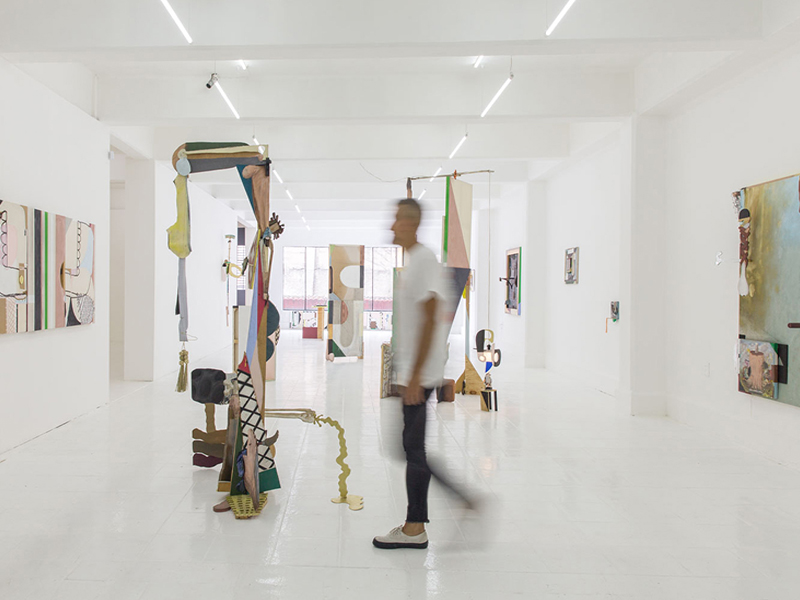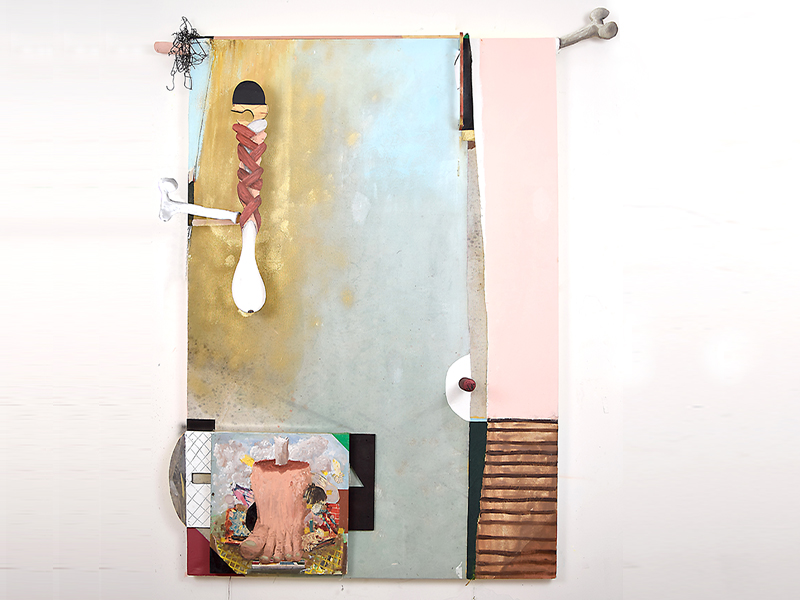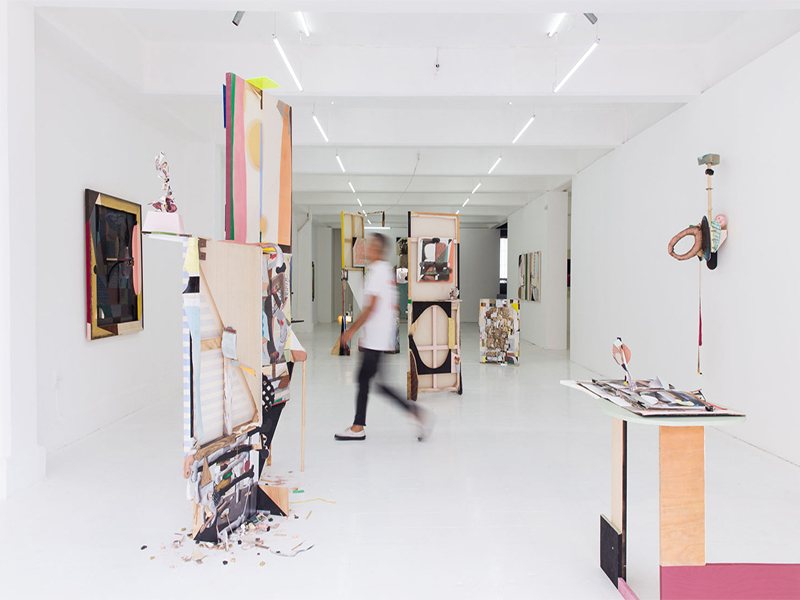Luis Hampshire
ARTIST
Luis Hampshire (OAXACA DE JUÁREZ, b. 1975)
PAINTING, SCULPTURE
ARTISTIC REFERENCES:

JUNE 2020
Is it possible to edit the future ?
Interview with Luis Hampshire
BY REGINA DE CON COSSÍO
Photographs Courtesy of the Artist
Artist, Independent Curator, and Art Promoter Luis Hampshire uses art to find his place in the world, to inhabit and understand it. Art as a medium permits him to separate from his own self and discover the otherness.
Hampshire studied arts at the Claustro de Sor Juana (USCJ) in Mexico City, he co-founded the art space Ediciones Plan B with Jessica Wzony. In addition to this, as an independent curator he has set up exhibitions nationally and internationally. Between 2011 and 2013 he directed the “Taller de Artes Plasticas Rufino Tamayo” (Rufino Tamayo Plastic Arts Workshop), in Oaxaca. Moreover, he was the director of MUPO (Museum of the Oaxaca Painters) .



His creative process dates back to his youth. The Imaginarium he lived in as a child in a small town was widened through the underground world of skateboarding, full of album covers and illustrations. This allowed him to draw contrast between his local world and other worlds. The discovery of this contrast set in motion his creative process. He is inspired by what can be found in the daily and ordinary, his passion for plants and architecture, design and crafts, high-culture, low-culture, crafts, food, literature and language, games, arts and of course artists. These influences are present in the art pieces he creates.
He views painting, his signature medium to create art, as a “world-platform”. It transcends beyond the technical and into a space to interact with meanings, contrasts and different worlds. Recurring elements in his works are the body and representations of it’s fragments, humor, sex and the derisory. Almost as an obsession coming back and forth we see the cutout and paste. In his work color is used as a mechanism to construct spatiality and narratives. Painting transforms into writing and exploring history traces.
He has the sensibility of an artist and the experience of running an Institution. This positions him in an interesting spot to have an opinion on the current challenges facing the art world.
Regina De Con Cossío: From your perspective, what is the role an artist should play in times of uncertainty?
Luis Hampshire: An advanced one, art has always been and is in the future possible. In these moments of closure not only health, but political, social and economic, art is important to dissent, diverge and generate a broad present that is consolidated in the future. But always from the possible, the democratic, the radical and the beautiful.
RDCC: Historically, the figure of the artist has been understood as an uncomprehended genius by society. However, in more recent times, art has been used as a manifestation of social participation. Should the artist take an active place in the social changes or is his duty to represent what is before his eyes?
LH: Making art is a political act in itself. Politics is the possibility of having a voice in the public space and art has it when it opens up to say the unspeakable. But going beyond the aesthetic and assuming an active role in the definition and expansion of identity, culture, democracy and politics in the now. Otherwise it is just decoration or a luxury souvenir.
RDCC: If artworks are usually seen in galleries, museums and public spaces, from your perspective, how will the dynamic change after the pandemic?
LH: The system of distribution and promotion of art has changed radically from the post-avant-garde to our days, and even more so with the expansion of the phenomenon by digital media and the internet. Now more than ever it is necessary to rethink the appropriate means and mechanisms for each medium, language and open up to everything. Nothing is fixed but in flow.
RDCC: Some of your work considers the world of screens as a space where new proposals can be made. Do you think that screens, cell phones, etc., are going to take an even more leading role to show and / or produce art? Will we see experimental and risky things on our cell phones?


LH: Yes and no. An important part of doing and living in art, as well as our body, has to do with the physical, the presence, the erotic of the encounter. The dialectic of the other that affects and alters me. In this way the presence of matter, the problem of the exhibition is only reconsidered through various mechanisms.
Not closing but opening is what is today. The radical is the multiple.
RDCC:If art ceases to show in museums and galleries and turns around screens. What will the role of the curator be? What will happen to the art fairs?
LH: I think the roles of the art world expand and find different paths. Museums, galleries, fairs and alternative spaces are developing alongside physical space in digital space. The job will be to put the correct messages on the correct media. Or deny them and rethink them in other formats. All this 2020 shows us that nothing closes but reinvents itself as a mechanism for survival or even resistance.
Hampshire’s work is currently exhibited at Karen Huber Gallery. I had the opportunity to visit and experience an outstanding trademark of his work. The whole setup gives the impression of walking through a stage’s scenography, as if a play is taking place. Yet by closer examination of each art piece, one discovers an autonomous scene on it’s own. The artist achieves this through the use of the collage technique and the marriage between different materials. Cuts and pastes, edited passages, overlapping worlds, layers of history, meanings reshaped. That’s what Hampshire’s work is about. Isn’t it also what we seem to be doing everyday, nowadays?
In a time of so much uncertainty due to the different crises we are experiencing (health, economic, social, etc.), what is the role of art in these discussions? Do you have something to propose to get closer to what we call reality? The question comes because you mention that in your work you use tools that put reality in tension.
I believe that in any crisis art can function as a prism through which we can observe reality in another way, as an image, with a more objective vision, or with other nuances. We can see things in more detail or perspective, as if art were a lens. I am not sure that the problem will be solved, but it can help to separate our consciousness from the present, to direct our gaze and attention towards something that we had overlooked, which could become a new route towards the exit of that crisis.
How has your perception changed from the last 12 months in which we have suffered a series of technological changes, communication and the way we understand social networks? Have your artistic practices been modified? Are the processes the same?
In the last year I have been working inside the studio, before I spent much more time in the derived part of the trip, the walk and the exploration in outdoor spaces. My practice has turned towards the formal reflection of the materials that I use. I try to keep the autobiographical element in the work, however there comes a time when the production in the same works takes me to places that escape my will, they are more intuitive in the sense that I do not have a preconceived image of what the final work, but each day they evolve by themselves. By spending
more time in the studio, I have been able to review ideas and works that I had on hiatus, waiting between papers. Now, by taking them up again, they take on a new meaning by merging with the ideas I am playing with in the present.
Do you notice any difference in the performative capacities of art in current times?
I see the performative part of the work in its socialization. I am struck by the ways in which artists now show or present a work, either through the internet or in a physical space. I think that’s where the performative is to be found. Today, with so many digital tools and communication channels available, works are susceptible to new mutations. A sculpture can be an object that the artist uses in a video, through which it relates an event, which ends up becoming a prophecy or an Instagram story. And what is the work, the sculpture, the video on Instagram or the whole process?
The concept of narrative is associated with literature, cinema, comics … It is a concept in which a story is told through a sequence of images or words. However, in your piece there also seems to be a story behind that unfolds in a circular or spiral way, how is it that a circular piece of art can be turned into a narrative platform? Is there a beginning, an end, a middle point? How do you approach this concept when making the artwork?
For me, a circular work is one that allows a possibility, that does not take something for granted but rather asks or even doubts what it is saying. I have always been interested in those elements that promote this kind of transition, such as the arrow or the hole. The arrow can be seen as an isolated object, and even then, even if they are not present, it always suggests a source and a destination. The hole or hole works in a similar way to the arrow, it is a space of transition and possibility, it is a threshold that separates the exterior and the interior, therefore it contains 2 moments in itself, with which a space-temporal narrative is generated.


